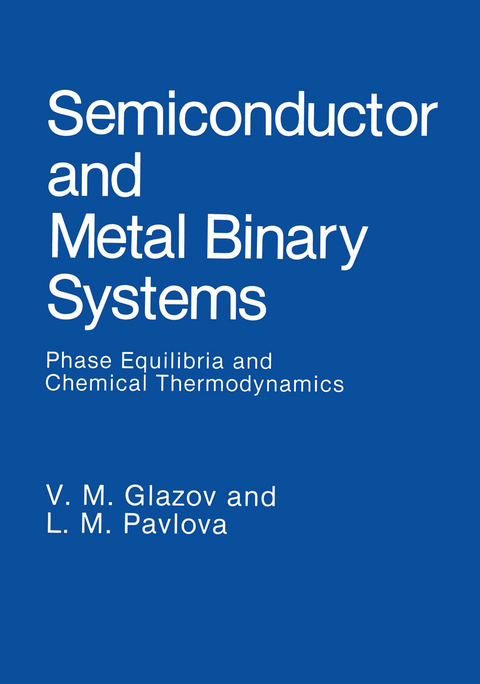
Semiconductor and Metal Binary Systems
Springer-Verlag New York Inc.
978-1-4684-1682-4 (ISBN)
1 Some General Relations of Chemical Thermodynamics.- 1. Systems, Their Properties and Classification. Thermodynamic Parameters and the Equation of State. Thermodynamic Processes.- 2. Partial Molar Quantities and Their Properties.- 3. The Zeroth, First, and Second Laws of Thermodynamics.- 4. Entropy Relations and Some Expressions Involving Derivatives of Thermodynamic Functions.- 5. Characteristic Thermodynamic Functions and the Gibbs-Helmholtz Equation.- 2 Theory of Chemical Potentials and the General Theory of Thermodynamic Equilibrium.- 1. Fundamental Theorems and Equations. The Gibbs-Duhem Equation.- 2. The Equilibrium Principle of Gibbs.- 3. Conditions for Phase Equilibrium. Real and Virtual Components.- 4. Conditions for Chemical Equilibrium. The Law of Mass Action.- 5. Criteria of Phase Stability in Heterogeneous Systems.- 6. The Principle of Equilibrium Displacement (the Gibbs-Le Chatelier Principle).- 7. Displacement along Equilibrium Lines. Generalized van der Waals Differential Equations.- 8. The Adequacy of Various Deductions of the Principle of Displacements along Equilibrium Lines.- 3 Phase Equilibria in Two-Component Systems.- 1. General Considerations on State Diagrams.- 2. The Isobaric-Isothermal Potential as a Function of Temperature, Pressure, and Concentration.- 3. Thermodynamic Derivation of Basic Types of State Diagrams in Two-Component Systems.- 4 Fundamentals of the Thermodynamic Theory of Solutions of Condensed Systems.- 1. Generalized Concept of Solution. Thermodynamic Classification of Solutions.- 2. Thermodynamic Functions of Mixing. Basic Properties and the Law of Ideal Solutions.- 3. The Law of Nonideal Solutions. Excess Thermodynamic Functions. Classification of Deviations from Ideality.- 4. The Concept of a Regular Solution. Lattice Modelof Solutions. Strictly Regular Solution and Its Modifications.- 5. Formal Description of the Thermodynamic Properties of Real Systems.- 6. Associated Solution Model.- 5 Thermodynamic Analysis of Phase Diagrams within Various Approximate Theories of Solutions.- 1. Analysis of Phase Equilibria Curves in Two-Component Systems Based on the Theory of Ideal Solutions.- 2. Interrelation of Various Types of Phase Equilibrium Diagrams and the Nature of Intermolecular Interactions.- 3. Analysis of Liquidus and Solidus Curves in Systems with Restricted and Unrestricted Solubilities.- 4. Thermodynamic Justification of the Retrograde Solidus. Calculation of the Retrograde Solidus in Various Approximations.- 5. Analysis of the Liquidus Curve of a Congruently Melting Compound AmBn in Various Approximations of Ideal Solutions.- 6. Equation of the Liquidus Curve and Thermodynamic Analysis of Systems with Incongruently Melting Compounds.- 7. Various Methods of Estimating the Exchange Energy from Experimental Data.- 8. Calculation of Thermodynamic Properties of Alloys from Data on Phase Equilibria.- 9. Choice of Model Solution Based on Matching with Experimental Phase Equilibrium Data.- 6 Thermodynamic Analysis of the Dissociation of Chemical Compounds.- 1. Shape and Position of Maxima in the Liquidus and Solidus Curves.- 2. Thermodynamic Basis of Various Estimation Procedures for the Dissociation Parameters of Congruently Melting Compounds.- 3. Estimates of the Degree of Dissociation of Chemical Compounds in Various Approximations of the Thermodynamics of Solutions.- 4. Dissociation of Binary Compounds in Quasibinary Solutions of Three-Component Systems.- Conclusion.- References.
| Zusatzinfo | 320 p. |
|---|---|
| Verlagsort | New York, NY |
| Sprache | englisch |
| Maße | 178 x 254 mm |
| Themenwelt | Naturwissenschaften ► Chemie ► Analytische Chemie |
| Naturwissenschaften ► Chemie ► Physikalische Chemie | |
| Naturwissenschaften ► Geowissenschaften ► Mineralogie / Paläontologie | |
| Naturwissenschaften ► Physik / Astronomie ► Atom- / Kern- / Molekularphysik | |
| Naturwissenschaften ► Physik / Astronomie ► Festkörperphysik | |
| Naturwissenschaften ► Physik / Astronomie ► Thermodynamik | |
| Technik ► Elektrotechnik / Energietechnik | |
| ISBN-10 | 1-4684-1682-0 / 1468416820 |
| ISBN-13 | 978-1-4684-1682-4 / 9781468416824 |
| Zustand | Neuware |
| Informationen gemäß Produktsicherheitsverordnung (GPSR) | |
| Haben Sie eine Frage zum Produkt? |
aus dem Bereich


